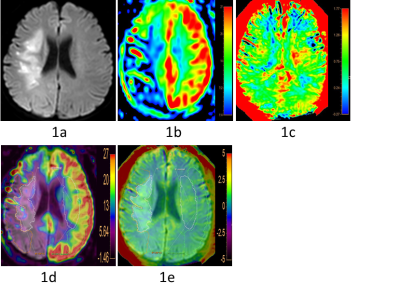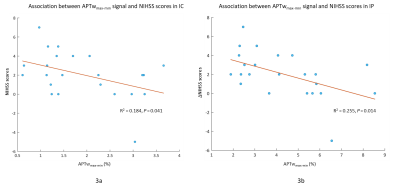Yuhan Jiang1, Peipei Chang1, Yingqiu Liuyang1, Bingbing Gao1, Yiwei Che1, Renwang Pu1, Qingwei Song1, Ailian Liu1, Zhiwei Shen2, Jiazheng Wang2, and Yanwei Miao1
1the First Affiliated Hospital of Dalian Medical University, Dalian, China, 2Philips Healthcare, Beijing, China
1the First Affiliated Hospital of Dalian Medical University, Dalian, China, 2Philips Healthcare, Beijing, China
In this study, we investigated the change of
APTwmax-min signals in the ischemic regions in the subacute
infarction, and elucidated the relationship with ∆NIHSS score. Results showed the
APTwmax-min signal was inversely correlated with ∆NIHSS score.

Fig 1 A 56-year-old
female with a subacute infarction 78 hours after the onset. a: DWI shows the
hyperintense infarct area near the right lateral ventricle. b: The infarct area
was low perfusion on the CBF image with 1.5 PLD. c: The infarct area was
slightly hypointense on the APTw image. d: DWI-CBF fusion map shows the IC and
IP. The ROI of the IC (white line) and the IP (orange line) is indicated. e:
DWI-APTw fusion map. The ROI was copied from the DWI-CBF fusion map.
